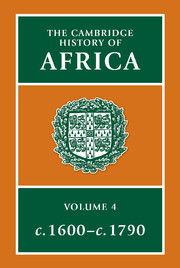Book contents
- Frontmatter
- Introduction
- 1 Egypt, the Funj and Darfur
- 2 The central Sahara and Sudan
- 3 North-West Africa: from the Maghrib to the fringes of the forest
- 4 The Guinea coast
- 5 Central Africa from Cameroun to the Zambezi
- 6 Southern Africa and Madagascar
- 7 Eastern Africa
- 8 Ethiopia and the Horn of Africa
- 9 Africa in Europe and the Americas
- Bibliographical Essays
- Bibliography
- Index
- References
6 - Southern Africa and Madagascar
Published online by Cambridge University Press: 28 March 2008
- Frontmatter
- Introduction
- 1 Egypt, the Funj and Darfur
- 2 The central Sahara and Sudan
- 3 North-West Africa: from the Maghrib to the fringes of the forest
- 4 The Guinea coast
- 5 Central Africa from Cameroun to the Zambezi
- 6 Southern Africa and Madagascar
- 7 Eastern Africa
- 8 Ethiopia and the Horn of Africa
- 9 Africa in Europe and the Americas
- Bibliographical Essays
- Bibliography
- Index
- References
Summary
Throughout the subcontinent south of the Zambezi, population densities, political power and many social developments were largely determined by agricultural production. Other economic activities could add comfort, magnificence and even relative luxury to life in some places. The foundations, however, rested firmly on agriculture, and rainfall, more than any human factor, influenced this basic activity. On the fringes of the Kalahari and in other arid areas, hunting or a meagre herding remained the key to bare survival. Elsewhere, over much of the cultivable area, population growth was severely limited by uncertain rainfall, and man's conquest of the harsh environment was still precarious. Yet in the more favoured areas, on the eastern plateaux and the plains flanking the Indian Ocean, a mixed agricultural economy maintained relatively dense and active populations. Here economic specialization and political centralization had developed many varied and resilient cultures. Here were the real centres of power in southern Africa, and before the end of the eighteenth century new crops, principally maize, had begun to increase – perhaps dramatically – the agricultural potential of some of these more favoured areas.
For more than a millennium, the mining and working of gold, copper and iron had provided a subsidiary source of wealth. In a few areas other industrial skills – fine pottery and cloth-weaving – were well established. These indigenous goods, together with salt and agricultural products, formed the basis of the internal trading networks. The export of gold from north of the Limpopo had also long attracted a flow of exotic imports, while in the seventeenth and eighteenth centuries the products of the hunt – ivory, skins and furs – became an increasingly important export from south of the Limpopo.
- Type
- Chapter
- Information
- The Cambridge History of Africa , pp. 384 - 468Publisher: Cambridge University PressPrint publication year: 1975
References
- 2
- Cited by



